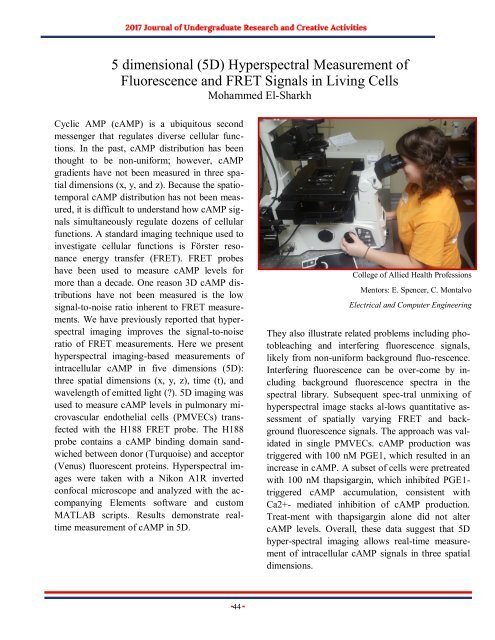JOURACA_SP_2017
You also want an ePaper? Increase the reach of your titles
YUMPU automatically turns print PDFs into web optimized ePapers that Google loves.
5 dimensional (5D) Hyperspectral Measurement of<br />
Fluorescence and FRET Signals in Living Cells<br />
Mohammed El-Sharkh<br />
Cyclic AMP (cAMP) is a ubiquitous second<br />
messenger that regulates diverse cellular functions.<br />
In the past, cAMP distribution has been<br />
thought to be non-uniform; however, cAMP<br />
gradients have not been measured in three spatial<br />
dimensions (x, y, and z). Because the spatiotemporal<br />
cAMP distribution has not been measured,<br />
it is difficult to understand how cAMP signals<br />
simultaneously regulate dozens of cellular<br />
functions. A standard imaging technique used to<br />
investigate cellular functions is Förster resonance<br />
energy transfer (FRET). FRET probes<br />
have been used to measure cAMP levels for<br />
more than a decade. One reason 3D cAMP distributions<br />
have not been measured is the low<br />
signal-to-noise ratio inherent to FRET measurements.<br />
We have previously reported that hyperspectral<br />
imaging improves the signal-to-noise<br />
ratio of FRET measurements. Here we present<br />
hyperspectral imaging-based measurements of<br />
intracellular cAMP in five dimensions (5D):<br />
three spatial dimensions (x, y, z), time (t), and<br />
wavelength of emitted light (?). 5D imaging was<br />
used to measure cAMP levels in pulmonary microvascular<br />
endothelial cells (PMVECs) transfected<br />
with the H188 FRET probe. The H188<br />
probe contains a cAMP binding domain sandwiched<br />
between donor (Turquoise) and acceptor<br />
(Venus) fluorescent proteins. Hyperspectral images<br />
were taken with a Nikon A1R inverted<br />
confocal microscope and analyzed with the accompanying<br />
Elements software and custom<br />
MATLAB scripts. Results demonstrate realtime<br />
measurement of cAMP in 5D.<br />
College of Allied Health Professions<br />
Mentors: E. Spencer, C. Montalvo<br />
Electrical and Computer Engineering<br />
They also illustrate related problems including photobleaching<br />
and interfering fluorescence signals,<br />
likely from non-uniform background fluo-rescence.<br />
Interfering fluorescence can be over-come by including<br />
background fluorescence spectra in the<br />
spectral library. Subsequent spec-tral unmixing of<br />
hyperspectral image stacks al-lows quantitative assessment<br />
of spatially varying FRET and background<br />
fluorescence signals. The approach was validated<br />
in single PMVECs. cAMP production was<br />
triggered with 100 nM PGE1, which resulted in an<br />
increase in cAMP. A subset of cells were pretreated<br />
with 100 nM thapsigargin, which inhibited PGE1-<br />
triggered cAMP accumulation, consistent with<br />
Ca2+- mediated inhibition of cAMP production.<br />
Treat-ment with thapsigargin alone did not alter<br />
cAMP levels. Overall, these data suggest that 5D<br />
hyper-spectral imaging allows real-time measurement<br />
of intracellular cAMP signals in three spatial<br />
dimensions.<br />
44

















